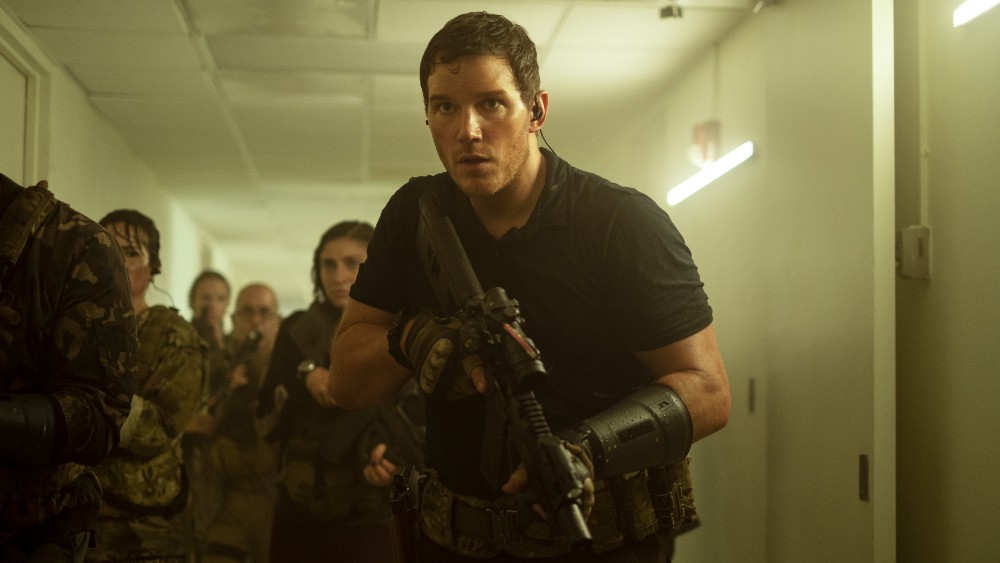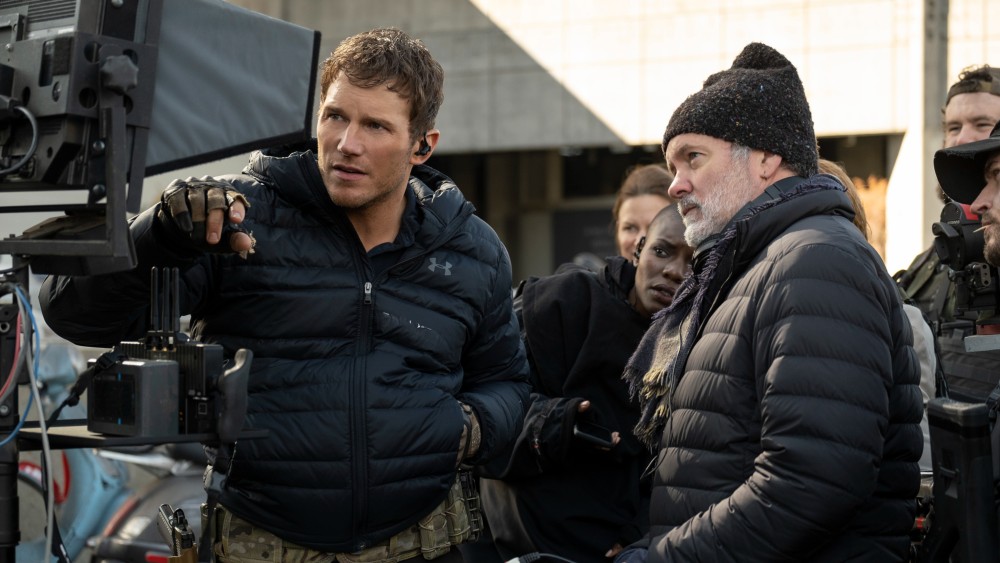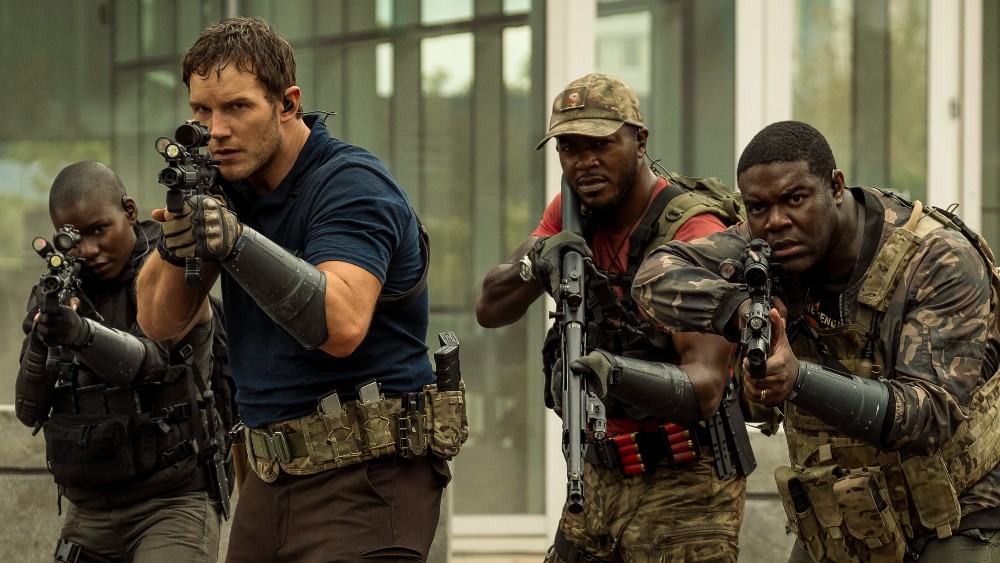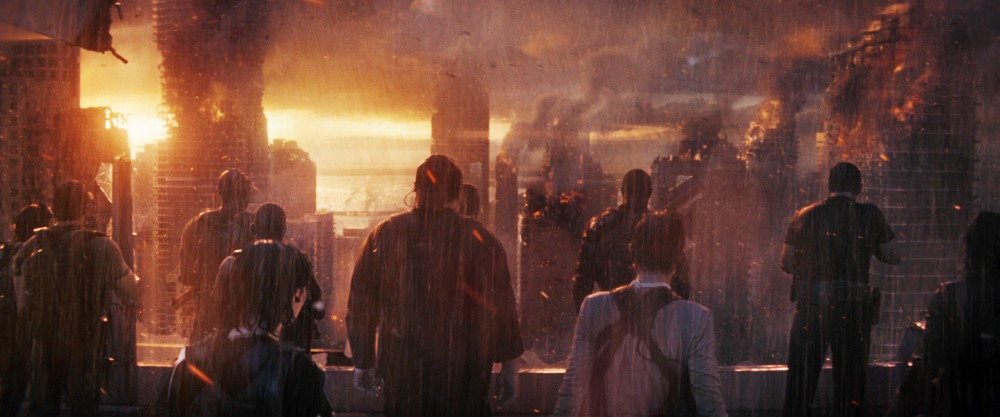
Director Chris McKay cut his teeth in animation, spending the second half of the ‘00s, as editor, co-producer and co-director, doing stop-animation series for the Cartoon Network’s “Adult Swim” brand that culminated in the highly-popular Robot Chicken. In 2017, McKay directed The Lego Batman Movie, released by Warner Bros. Pictures, which was a much bigger full CG animated movie, which already has a sequel lined up for next year.
Even so, The Tomorrow War is much bigger than anything else McKay has done, and not just because of the bigger budget or the fact that he’s working with full-size living actors rather than the stop-motion models from his earlier work.
One of those actors is Chris Pratt from Guardians of the Galaxy, who plays Dan Forester, a former military man who has been working as a high school teacher, but who is called to duty to save the world of the future when time travelers from 2051 travel back in time to warn the world that vicious aliens are wiping out the humanity of the future. In order to save the world for his young daughter, Dan takes up the mission, not realizing how dangerous and desperate the battle will be.
The Tomorrow War is very much the kind of big summer movie we might normally get from a James Cameron or Michael Bay with humor and insane action setpieces that show off brilliant creature design and visual effects work in creating the deadly aliens that seem more than capable of wiping out humanity.
Below the Line got on Zoom with Mr. McKay a few weeks back for the following interview, where he was more than ready to talk about all his great below-the-line peeps.

Below the Line: Since this is your first live-action film, I’m going to go with the most obvious question, which is what was about the script that made you decide this was going to be the first live-action film you directed?
Chris McKay: It was a script that came across my desk called Ghost Draft. That was what the title of the movie was originally, and it was a big epic sci-fi action movie which had elements of horror, or at least what I thought were gonna be [considered] horror in it, and a lot of scope and scale and a lot of fun twists and stuff like that. There was also an emotional story in the middle of it — a family story, a character study. That’s always what I’ve been looking for. I like scope, and I like big action set pieces, and I’m a guy who grew up on Spielberg movies and John Carpenter movies and George Miller movies and James Cameron. Those are the filmmakers that I love, the films that I love, and so to have a movie that traffics in the scope and scale of something like that, but also, there’s a family drama at its heart, and it’s a movie that sometimes wears his heart on his sleeve. Those were my hopes and dreams as a filmmaker, and that’s what I was hoping for I was hoping I could marry all the things that I loved about filmmakers as diverse as John Carpenter to John Cassavetes. How can I make something that has a little bit of both of that in there? So I was very lucky to get the opportunity to read that script, and very lucky that they chose me to direct.
BTL: We often speak to directors about their crew and heads of department, and you have some great people on this one. Larry Fong is an amazing DoP — your production designer, Peter Wenham, also amazing. How do you put together such an amazing crew like this?
McKay: Look, having Chris Pratt as your lead goes a long way — I’m lucky that Chris Pratt was attached to the script. I had to audition for Chris to get this job, so people, when they see Chris Pratt in a movie, they take that movie seriously — I think a lot of people want to work with Chris. I was very lucky to work with Larry Fong. Very lucky to work with Peter Wenham, [Costume Designer] Betsy Heimann, [Visual FX Supervisor] James E. Price, [Propmaster] Gary Tuers. We had a murderer’s row of amazing… talk about below the line people.
Peter Wenham, Fast Five, the crazy fast and furious bank vault chase, and also then Captain America: Winter Soldier, which is probably my favorite Captain America movie — Peter Wenham did that. Obviously, Larry Fong shot all those Zack Snyder movies and JJ Abrams, he did Super and Lost for JJ Abrams, amazing stuff. Betsy Heimann, designing the costumes for Reservoir Dogs, Pulp Fiction, Jerry Maguire, Almost Famous. She works on Tarantino’s greatest movies, Cameron Crowe’s greatest movies. James E. Price, visual effects. Gary Tuers, props, he did Transformers movies, he did Magnificent 7, John Wick. All the guns that had in the movie Gary designed.
Yeah, I mean, we had a really great …. Lukas [Bielin], Camera Operator, amazing! Just like amazing people all down the line. Roger Barton, Editor, he worked with the Wachowskis, he worked with Michael Bay, worked with George Lucas. He worked on [Star Wars:] Revenge of the Sith, and Titanic, just an amazing team. I’ve just been really lucky.

BTL: Did you find that there were counterparts in animation that were equivalent to all those roles? Obviously, you have design and photography in animation, but was it easy to transition to having hundreds of humans on set?
McKay: No, it’s really easy. You do a lot of the same kinds of things. You do a lot of previs. The same kind of previs you do for an animated movie, you do for a movie like this. With a villain being somebody who is not on set, we have to create our villains, so there’s a lot of stuff that you do ahead of time to get the crew and everybody to get their heads wrapped around the movie. Previs and storyboards and the animatic are just really great tools to help everyone get on the same page. It’s the same thing you do in animation when you’re building reels. Before you start spending a lot of money you want to be as prepared as humanly possible. So yes, it’s very similar. You are working with some of those people… the tools of animation, you’re talking about lenses, especially when you’re doing something in CG. Also, in stop motion, when I’m on set when I was on Robot Chicken or Moral Orel or Titan Maximum, and we’re doing stop-motion, I’m setting up the camera, we’re changing up the lenses, we’re talking in terms of lenses, and so in CG, you’re talking lenses and F-stop, so a lot of it’s the same kind of stuff. You just can’t erase stuff you do on set.
BTL: Can you talk a little more about the production design and the locations. That base, for instance, is particularly impressive. I’m not sure how much of that is a location or a soundstage or just CG. What was involved with that, and were there a lot of big locations or was a lot of that just clever use of CG?
McKay: I wanted to shoot as much stuff practically as possible, and Peter Wenham was instrumental in me being able to do that. For instance, with Deep Swell, the oil rig base in the middle of the movie, that was a combination of obviously stuff that was CG, but it was stuff that was CG based on a real location that we used. It’s a power plant outside of Atlanta. It’s a Georgia power plant that we used, which looks a lot like an oil rig, as far as the tight quarters and all the different kinds of things that you need — catwalks and stuff like that. We were able to use that location, and then do enhancements to that location, whether it’s stuff that you see behind them, or other kinds of little tweaks, and then stuff that we did on set that sort of made it feel like an oil rig. Even though it’s a pain in the ass to get to that location, and they don’t have elevators, so if you’re trying to get a dolly up to the fourth floor, we have to build our own elevator to get equipment up there. But everyone here… I had a great crew and a great team who really rose to the challenge. They figured out ways for us to be able to do the stuff that we needed to do, but it’s that kind of thing that, to me, makes a big difference. Because I don’t want something that sort of feels like it’s shot on a stage. Even though, there’s stuff that we did shoot on stages, very rarely was there not a physical component to it.
When we wanted to shoot in ice caves, we built ice caves. We built some things on set, like the stairwell was a set, even though every other aspect of that building was a building that we found and used and dressed that building, when they’re walking down that hallway, and they’re heading toward that stairwell, there’s a door to that hallway that just opened up to another room. We just had the camera go straight to that door, had a character cross the frame, and then on the top of the stairwell set, had that same person cross the frame again, and then we match that. Even though it looks like one take, it’s actually two shots, shot at two different times in two different location — one on location, one on set — and then that way, it just felt like one continuous thing leading into that stairwell. But I prefer to shoot stuff practically as much as possible and try to do as little [in computer] as you can.
BTL: That’s amazing. I also want to talk about the creature design, because that’s another big factor. There are some obvious inspirations in there, but it’s also something quite different. Who was involved with that, and what were your conversations like?
McKay: We had to talk to a lot of designers, people like Aaron Sims and other people like that who worked on it, including [Creature Designer] Ken Barthelmey, his design. To all the designers, I said I wanted something that felt like it was a million years old. How can this thing feel ancient? How can this feel like from another time? How can it feel like it’s hungry all the time, and that it’s got an insatiable appetite? How can it feel with teeth [that are] like a dental nightmare? How can I understand that maybe it has a feral intelligence like coyotes and wolves? It can communicate with others around it to run a play to go after its prey, things like that. Those are the things we talked about. And Ken came up with this really interesting design. I also knew that I wanted it to have offensive weapons, that it was probably going to need like tentacles or something like that in order to do that. Ken came up with something that’s incorporated a lot of these thoughts, and then we just kept adding texture, texture, texture, throughout the VFX process to really make it feel like it came alive.
BTL: Did the actors have something on set to look at that was as insanely vicious and brutal as those creatures, to put them in the mindset of facing something like that in real life? Did you have something to get them in the mood and to know what they were facing?
McKay: Spectral [Motion] not only designed not only an animal animatronic version of it, that we use in a couple of shots and scenes, but we also had a head that some guy would often use when we were doing the blocking, and then even in the shot. So we had a head that we used, we had sort of an upper torso body and head thing that we used occasionally. Sometimes, we’d just use that in blocking, or to get eyelines and things like that, or [for] the very first shot, we’d do a couple of shots with the head version, and Troy [Faruk], the stunt guy who is about seven feet tall, would hold this thing and run at our heroes. But then usually after like take two or whatever, I’d have the actors try to do one without it, so they would just be using their imagination, sense memory of the blocking, and then also trying different things because then they can kind of improvise a little bit and try stuff out, so that stuff would happen a little more spontaneously. We tried a bunch of different stuff and a lot of times, it was just the actors using their imagination.
BTL: I don’t know what the timeframe was, but did you have this done before COVID, or were you still doing post during COVID?
McKay: We finished shooting it January 15, 2020 — a month and change before lockdown happened. So yeah, we finished shooting it just in time, and we were in post. Basically, once the lockdown happened, we kind of took a minute to sort of reassess what we’re going to do. And then we just sent everyone’s computers home to them, and then tried to do everything remotely, which was a lot of fun, because it kind of bonded everybody. It was a challenge, because it wasn’t the way people were used to working or their process. But all throughout this, I’ve just been really buoyed by the crew and their ability to just kind of roll with stuff that we’ve been thrown. We went through a lot of stuff on this movie to try and get a big movie like this done. Even though it’s a big budget movie, you’re always still trying to figure out how to get as much as your vision, your appetite, is, in the can, so this crew, every single time, always rose to the challenge, and tried to make the best movie we possibly could make.
BTL: This is another movie where you would never know that all the post was done during a pandemic, because it looks and sounds amazing. I wish I could have seen it on a big screen rather than on my laptop. Before going, I just want to ask you if Nightwing is something you might still be doing? That’s one of the movies I’ve been tracking for a while, and it’s just a terrific character in the comics.
McKay: I really hope we’re gonna do that movie. I still think there’s a possibility to do that movie. Warner Brothers never said we’re NOT making this movie. They just had other priorities and other things –as you can imagine, especially the past year, they have other things that they’ve prioritized that they need to focus on for good reason. They’ve had great success recently, so I’m hoping that we get to make a Nightwing movie really soon.
The Tomorrow War hits Amazon Prime Video this Friday, July 2.
All pictures courtesy Amazon Prime Video.






